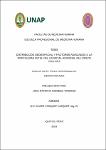| dc.contributor.advisor | Vásquez Vásquez, Javier | |
| dc.contributor.author | Noriega Trigoso, Lidia Patricia | |
| dc.date.accessioned | 2024-01-18T04:03:55Z | |
| dc.date.available | 2024-01-18T04:03:55Z | |
| dc.date.issued | 2023 | |
| dc.identifier.other | 618.392 N82 2023 | |
| dc.identifier.uri | https://hdl.handle.net/20.500.12737/9704 | |
| dc.description.abstract | Objectives. Determine the geospatial distribution and factors associated with fetal death registered at the Loreto Regional Hospital from 2018 to 2022.
Materials and methods. Observational, descriptive and cross-sectional study. The clinical history databases of fetal deaths registered at the Loreto Regional Hospital between the years 2018 to 2022 were used. Data on maternal, neonatal characteristics, the temporal profile of the registry, as well as its spatial or geographic registration were assessed. The data selected from the search strategy were exported and descriptive statistics of frequency and percentage were obtained. QGIS software was used to generate geographic and heat maps for population density by cluster and by specific points.
Results. Of 246 registered cases, 03 were excluded, leaving a sample of 243 cases of fetal deaths during the study period, where it was found that the year 2019 had the highest number of fetal deaths registered with 33.9% of the total in the period studied, in contrast 2020 had a decrease in the number of fetal deaths registered, representing 16.4% of the total. The districts with the highest density of cases were San Juan, Iquitos and Punchana, and the provinces with the most intense hot spots were Maynas, Loreto and Ramón Castilla. A significant association was observed between area of residence and fetal death (p=0.001), with a higher incidence in the urban area compared to the rural area. In addition, a significant relationship was detected between educational level and fetal death (p=0.020), with a higher percentage of fetal deaths among mothers with primary education in the non-capital district.
Conclusions. Fetal deaths registered at the Loreto Regional Hospital are distributed predominantly towards the east and south of the region, with higher rates in the provinces of Maynas, Loreto and Ramón Castilla. Maternal education and area of origin are factors that are associated with fetal mortality in districts with higher population density of Loreto. | en_US |
| dc.description.abstract | Objetivos: Determinar la distribución geoespacial y los factores asociados a la mortalidad fetal en el Hospital Regional de Loreto desde 2018 hasta 2022.
Materiales y método: Estudio de tipo observacional, descriptivo, transversal. Se emplearon las bases de datos historias clínicas de muertes fetales registradas en el Hospital Regional de Loreto entre los años 2018 a 2022. Se valoraron datos sobre características maternas, neonatales, el perfil temporal del registro, así como su registro espacial o geográfico. Los datos seleccionados de la estrategia de búsqueda fueron exportados y se obtuvieron estadísticas descriptivas de frecuencia y porcentaje. Se utilizó el software QGIS para generar mapas geográficos y de calor para densidad poblacional por cluster y por puntos específicos.
Resultados: De 246 casos registrados, se excluyeron 03, quedando una muestra de 243 casos de muertes fetales durante el periodo de estudio, donde se encontró que el año 2019 tuvo la mayor cantidad de muertes fetales registradas con un 33.9% del total en el periodo estudiado, en contraste el año 2020 tuvo una disminución en la cantidad de muertes fetales registradas, representando el 16.4% del total. Los distritos con más densidad de casos corresponden a San Juan, Iquitos y Punchana, así como las provincias con punto de calor más intenso fueron Maynas, Loreto y Ramón Castilla. Se observó una asociación significativa entre la zona de residencia y la muerte fetal (p=0.001), con una mayor incidencia en la zona urbana en comparación con la zona rural. Además, se detectó una relación significativa entre el nivel educacional y la muerte fetal (p=0.020), con un mayor porcentaje de muertes fetales entre madres con educación primaria en el distrito no capital.
Conclusiones: Las muertes fetales registradas en el Hospital Regional de Loreto presentan distribución predominantemente hacia el este y sur de la región, con mayores tasas en las provincias de Maynas, Loreto y Ramón Castilla. La educación materna y la zona de procedencia son factores que se asocian a la mortalidad fetal en distritos de mayor densidad poblacional de Loreto. | es_PE |
| dc.format | application/pdf | es_PE |
| dc.language.iso | spa | es_PE |
| dc.publisher | Universidad Nacional de la Amazonía Peruana | es_PE |
| dc.rights | info:eu-repo/semantics/openAccess | * |
| dc.rights.uri | https://creativecommons.org/licenses/by/4.0/ | * |
| dc.subject | Mortalidad fetal | es_PE |
| dc.subject | Datos geoespaciales | es_PE |
| dc.subject | Factores de riesgo | es_PE |
| dc.subject | Hospitales | es_PE |
| dc.title | Distribución geoespacial y factores asociados a la mortalidad fetal del Hospital Regional de Loreto 2018-2022 | es_PE |
| dc.type | info:eu-repo/semantics/bachelorThesis | es_PE |
| thesis.degree.discipline | Medicina Humana | es_PE |
| thesis.degree.grantor | Universidad Nacional de la Amazonía Peruana. Facultad de Medicina Humana | es_PE |
| thesis.degree.name | Médico Cirujano | es_PE |
| dc.subject.ocde | https://purl.org/pe-repo/ocde/ford#3.02.02 | es_PE |
| renati.author.dni | 72366493 | |
| renati.advisor.orcid | https://orcid.org/0000-0002-0507-6456 | |
| renati.advisor.dni | 5263634 | |
| renati.type | https://purl.org/pe-repo/renati/type#tesis | es_PE |
| renati.discipline | 912016 | es_PE |
| renati.level | https://purl.org/pe-repo/renati/level#tituloProfesional | es_PE |
| renati.juror | Rodriguez Ferrucci, Hugo Miguel | |
| renati.juror | Pinedo Cancino, Viviana Vanessa | |
| renati.juror | Seminario Vilca, Juan Raúl | |
| dc.publisher.country | PE | es_PE |





